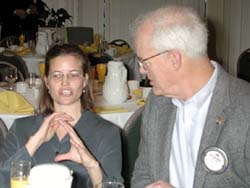|
Impact of Endangered Species Act Spelled Out
|

Jim Owens talks with Hilary Culverwell after Friday’s presentation.
|
Hilary Culverwell, Outreach Coordinator for the King County Department of Natural Resources/Parks, laid out the early first steps for salmon recovered in the Lake Washington basin. Culverwell, a Mercer Island High School graduate, earned a degree at Occidental College in California and a Masters degree at Indiana University.
“This subject has been going on for sometime. A student recently said at a presentation I was making, ‘I’m so bored by it all.’ It will still go on for a long time, because there are so many facets about salmon recovery.”
The Lake Washington Basin, known as WRIA 8, includes the Cedar River and Sammamish River watersheds and the Lake Washington basin. It is the most densely populated recovery area in the state. Because of this, it contains the most complex issues.
Ms. Culverwell gave an overview on “The Salmon Problem.” “There are seven species of Pacific salmon: Chinook, Coho, Chum, Sockeye, Pink, Steelhead, and Cutthroat (Bull) Trout. Steelhead and Bull Trout are technically not salmon, but are endangered and have some of the same characteristics as salmon.”
She continued: “Since 1900, wild, native salmon have disappeared from 40% of their historical breeding grounds; 44% of the remainder are at risk; 106 stocks have already become extinct. Being listed as ‘endangered’ means almost a ‘September 11th-type’ event for fishery. Is it a crisis? Many people think so.”
The Puget Sound Watershed encompasses 12 counties, 18 major watersheds, and is designated as an evolutionary significant unit (ESU).
Why are salmon in trouble?
There are four basic reasons, the four H’s: 1) Harvest; 2) Hatcheries; 3) Hydropower dams; and 4) Habitat Degradation and Loss. “Number 4 is the one we can control. Habitat is a local issue … it’s a major item in the impact of the listing.”
Defining habitat, it is a temporary or permanent part of the biosphere. “In order to protect salmon, you’ve got to look at their habitat,” Hilary observed. “The life cycle and migration of salmon from fresh water to salt water and return is one of nature’s amazing happenings. They usually return to the stream of their birth to spawn and die, and then the cycle begins again. Their journey amounts to thousands of miles, a very remarkable event.”
The Endangered Species Act prohibits any person from “harassing, harming, pursuing, hunting, shooting, wounding, killing, trapping, capturing or collecting any listed threatened or endangered species.” “We do harm to streams by landowners’ actions, and 30% of the reduction in salmon stocks is due to habitat loss. So, local governments and citizens have a big stake in this.”
What is being done in the Lake Washington basin?
“First we must recognize that there are 1.25 million people living in the watershed. As far as salmon conservation planning is concerned, there has never been an endangered species listing in an urban area. Because of this, a multi-stockholder process has been put in motion to put in place plans for salmon recovery. The stockholders involve the counties of King and Snohomish, and 24 cities (including Bellevue) have signed the agreement to try and solve the issue.”
Challenges
- What do we know now?
- What can we do now?
- What do we need to learn?
- What do we do in the future?
“We know where the salmon are and where they live or frequent. We need to acquire property and change regulations. Once that’s accomplished, they will fill in the data gaps.
It’s a long-term timeline that takes us out to 2005. It’s hard to keep people engaged when it takes so long to fully recover the species. Estimates say it will take 200-500 years for the species to fully recover.”
What’s being done?
“We are holding public meetings. I urge you to GO and TESTIFY. On the ground now, here’s what’s happening. There are an incredible number of projects currently going on – the Kelsey Creek Fish Passage Project conducted by the City of Bellevue; a project experimenting with “Nurse Logs” which give vegetation growth and protection along streams; Ballard Locks Restoration Project by the Army Corps of Engineers. This project is upgrading fish passage to decrease mortality rates, and they’re installing smolt slides which are helping the movement of these fragile young fish significantly. There are lots of acquisition projects in place.”
Hilary offered ideas of what we can do to mitigate our impact on the environment. “We should conserve water, water our lawns and gardens carefully, wash our cars in the carwash, and recycle used motor oil.”
As to where this all leads, Hilary quoted Bob Fuerstenberg, ecologist, for the King County Department of Natural Resources. ”If we’re the people we think we are, we’ll recover salmon. If we’re not, we won’t.“
In the Q & A time, Hilary noted that many participating agencies feel they’re under the gun. “There is a fear of the Endangered Species Act, of being sued. Local government is working well and lots of dedicated people are working hard to bring about salmon recovery.”
Thanks to Alex Rule for his introduction.
For her presentation, Hilary was presented a Certificate of Donation to Rotary First Harvest, where the BBRC has purchased 700 pounds of food in her name for use by needy families.
|